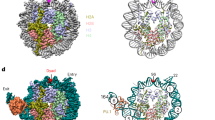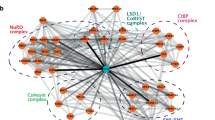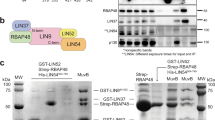Abstract
PU.1, a member of the Ets family of transcription factors, is implicated in hematopoietic cell differentiation through its interactions with other transcriptional factors and cofactors. To identify a novel protein(s) binding to PU.1, we carried out affinity purification using a column of Glutathione-Sepharose beads bound to GST-PU.1 fusion protein and isolated several individual proteins using murine erythroleukemia (MEL) cell extracts. Sequence analysis of these proteins revealed that one was MeCP2 a methyl CpG binding protein. GST-pull-down assay and immunoprecipitation assay showed that PU.1 bound directly to MeCP2 via its Ets domain and MeCP2 bound to PU.1 via either its amino terminal domain or trans-repression domain. MeCP2 repressed transcriptional activity of PU.1 on a reporter construct with trimerized PU.1 binding sites. This downregulation was recovered in the presence of histone deacetylase inhibitor, trichostatin A (TSA). MeCP2 was integrated in PU.1-mSin3A-HDAC complex but not in PU.1-CBP complex. Chromatin immunoprecipitation (ChIP) assays showed that PU.1 and MeCP2 were collocated at the PU.1 binding site on the reporter construct and the PU.1 binding site of the intervening sequence 2 (IVS2) region in the intron of the β-globin gene, which has been proposed to regulate expression of the gene, in undifferentiated MEL cells. The complex disappeared from the region during the course of erythroid differentiation of MEL cells. Our results suggest that MeCP2 acts as a corepressor of PU.1 probably due to facilitating complex formation with mSin3A and HDACs.
This is a preview of subscription content, access via your institution
Access options
Subscribe to this journal
Receive 50 print issues and online access
$259.00 per year
only $5.18 per issue
Buy this article
- Purchase on Springer Link
- Instant access to full article PDF
Prices may be subject to local taxes which are calculated during checkout









Similar content being viewed by others
References
Bannister AJ, Oehler T, Wilhelm D, Angel P and Kouzarides T . (1995). Oncogene, 11, 2059–2514.
Bassuk AG and Leiden JM . (1995). Immunity, 3, 223–237.
Boyes J, Byfield P, Nakatani Y and Ogryzko V . (1998). Nature, 396, 594–598.
Chawla S, Hardingham GE, Quinn DR and Bading H . (1998). Science, 281, 1505–1509.
Czuwara-Ladykowska J, Sementchenko VI, Watson DK and Trojanowska M . (2002). J. Biol. Chem., 277, 20399–20408.
Eisenbeis CF, Singh H and Storb U . (1995). Gene Dev., 9, 1377–1387.
Datta J, Ghoshal K, Sharma SM, Tajima S and Jacob ST . (2003). J. Cell Biochem., 88, 855–864.
Fuks F, Burgers WA, Godin N, Kasai M and Kouzarides T . (2001). EMBO J., 20, 2536–2544.
Furia B, Deng L, Wu K, Baylor S, Kehn K, Li H, Donnelly R, Coleman T and Kashanchi F . (2002). J. Biol. Chem., 277, 4973–4980.
Galson DL, Hensold JO, Bishop TR, Schalling M, D'Anderea AD, Jones C, Auron PE and Housman DE . (1993). Mol. Cell. Biol., 13, 2929–2941.
Hagemeier C, Bannister AJ, Cook A and Kouzarides T . (1993). Proc. Natl. Acad. Sci. USA, 90, 1580–1584.
Huang S and Brandt SJ . (2000). Mol. Cell Biol., 20, 2248–2259.
Jones PL, Veenstra GJ, Wade PA, Vermaak D, Kass SU, Landsberger N, Strouboulis J and Wolffe AP . (1998). Nat. Genet., 19, 187–191.
Kihara-Negishi F, Yamamoto H, Suzuki M, Yamada T, Sakurai T, Tamura T and Oikawa T . (2001). Oncogene, 20, 6039–6047.
Klemsz MJ, McKercher SR, Celeda A and Maki RA . (1990). Cell, 61, 113–124.
Konishi Y, Tominaga M, Watanabe Y, Imamura F, Goldfarb A, Maki R, Blum M, DeRobertis EM and Tominaga A . (1999). Oncogene, 18, 6795–6805.
Mal A, Sturniolo M, Schiltz RL, Ghosh MK and Herter ML . (2001). EMBO J., 20, 1739–1753.
McKercher SR, Torbett BE, Anderson KL, Henkel GW, Vestal DJ, Baridault H, Klemsz M, Feeney AJ, Wu GE, Paige CJ and Maki RA . (1996). EMBO J., 15, 5647–5658.
Meehan RR and Bird AP . (1992). Nucl. Acids Res., 20, 5085–5092.
Moreau-Gachelin F . (1994). Biochim. Biophys. Acta, 1198, 149–163.
Moreau-Gachelin F, Wending F, Molina T, Denis N, Titeux M, Grimber G, Briand P, Vainchenker W and Tavitian A . (1996). Mol. Cell. Biol., 16, 2453–2463.
Nagulapalli S, Pongubala JM and Atchison ML . (1995). J. Immunol., 155, 4330–4338.
Nan X, Ng HH, Johnson CA, Laherty CD, Turner BM, Eisenman RN and Bird A . (1998). Nature, 393, 386–389.
Oelgeschlager M, Nuchprayoon I, Luscher B and Friedman AD . (1996). Mol. Cell. Biol., 16, 4717–4725.
Petrovick MS, Hiehert SW, Friedman AD, Hetherington CJ, Tenen DG and Zhang DE . (1998). Mol. Cell. Biol., 18, 3915–3925.
Polesskaya A, Duquet A, Naguibneva I, Weise C, Vervisch A, Bengal E, Hucho F, Robin P and Harel-Bellan A . (2000). J. Biol. Chem., 275, 34359–34364.
Pongubala JMR and Atchison ML . (1997). Proc. Natl. Acad. Sci. USA, 94, 127–132.
Pongubala JMR, Nagulapalli S, Klemsz MJ, McKercher SR, Maki RA and Atchison ML . (1992). Mol. Cell. Biol., 12, 368–378.
Rao E, Dang W, Tian G and Sen R . (1997). J. Biol. Chem., 272, 6722–6732.
Razin A and Riggs AD . (1980). Science, 210, 604–616.
Robertson KD . (2001). Oncogene, 20, 3139–3155.
Robertson KD, Ait-Si-Ali S, Yokochi T, Wade PA, Jones PL and Wolffe AP . (2000). Nat. Genet., 25, 338–342.
Rountree MR, Bachman KE and Baylin SB . (2000). Nat. Genet., 25, 269–277.
Sakaguchi K, Herrera JE, Saito S, Miki T, Bustin M, Vassilev A, Anderson CW and Appella E . (1998). Gene Dev., 12, 2831–2841.
Sartorelli V, Puri PL, Jamamori Y, Ogryzko V, Chung G, Nakatani Y, Wang JY and Kedes L . (1999). Mol. Cell, 4, 725–734.
Schuetze S, Paul R, Gliniak BC and Kabat D . (1992). Mol. Cell. Biol., 12, 2967–2975.
Scott EW, Simon MC, Anastasi J and Singh H . (1994). Science, 265, 1573–1577.
Singal R and Ginder CD . (1999). Blood, 93, 4059–4070.
Tenen DC, Hromas R, Licht JD and Zhang D-E . (1997). Blood, 90, 498–519.
Yamada T, Kondoh N, Matsumoto M, Yoshida M, Maekawa A and Oikawa T . (1997). Blood, 89, 1383–1393.
Yamamoto H, Kihara-Negishi F, Yamada T, Hashimoto Y and Oikawa T . (1999). Oncogene, 18, 1495–1501.
Zhang DE, Hetherington CJ, Chen HM and Tenen DG . (1994). Mol. Cell. Biol., 14, 373–381.
Zhong H, Voll RE and Ghosh S . (1998). Mol. Cell, 1, 661–671.
Acknowledgements
We wish to thank Dr I Kitabayashi for expression plasmids of mSin3A and HDAC1, and Dr C Jones for pTK100-Luc reporter plasmid. This work was mainly supported by a Grant-in-Aid for Encouragement of Young Scientist (to MS) from the Ministry of Education, Science and Culture of Japan, and a Grant from the Nishi Foundation, Tokyo, Japan. Financial supports to T O from Dr J Akiyama, OBGYN Akiyama Memorial Hospital, Hakodate, Dr K Watanabe, Watanabe Clinic, Shizuoka, and Dr K Tanzawa, Sankyo Ltd., Tokyo, Japan, are also acknowledged.
Author information
Authors and Affiliations
Corresponding author
Rights and permissions
About this article
Cite this article
Suzuki, M., Yamada, T., Kihara-Negishi, F. et al. Direct association between PU.1 and MeCP2 that recruits mSin3A-HDAC complex for PU.1-mediated transcriptional repression. Oncogene 22, 8688–8698 (2003). https://doi.org/10.1038/sj.onc.1207182
Received:
Revised:
Accepted:
Published:
Issue Date:
DOI: https://doi.org/10.1038/sj.onc.1207182
Keywords
This article is cited by
-
Role of HDACs in normal and malignant hematopoiesis
Molecular Cancer (2020)
-
Safeguard function of PU.1 shapes the inflammatory epigenome of neutrophils
Nature Immunology (2019)
-
Old dog PU.1 reveals new tricks
Nature Immunology (2019)
-
Epigenetics in radiation-induced fibrosis
Oncogene (2015)
-
Epigenetic silencing of Bim transcription by Spi-1/PU.1 promotes apoptosis resistance in leukaemia
Cell Death & Differentiation (2013)



